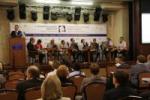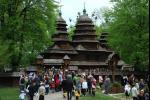- عربي
- Ukraine
- Economy
-
Investment
- Current Investment Trends
- Legal Conditions of Doing Business
- Investment Policy
- Competition
- Setting a Business in Ukraine
- Mergers and Acquisitions
- Taxation
- Import and Export
- Banks and Bank Regulation
- Convertibility and Profits Repatriation
- Currency Regulation
- Protection of Intellectual Property Rights
- Companies
- Travel to Ukraine
- About us
- Useful Sites
- Gallery
- News
Currency rates in UAH
| AED | ||
| BHD | ||
| EGP | ||
| KWD | ||
| LBP | ||
| OMR | ||
| QAR | ||
| SAR | ||
| SYP |
2015-07-06
| Kiev |  |
+32 |
| Donetsk |  |
+28 |
| Dnipropetrovsk |  |
+31 |
| Lviv |  |
+31 |
| Odessa |  |
+27 |
Halytsian-Volynian Principality
After the disintegration of the Old Rus state in the 12th century into separate regional formations, the Halytsian-Volynian principality had undertaken the state-creating traditions of Rus. In spite of devastating wars which had not passed through the principality, there was still a certain stabilization of economic and political development that was observed in this area in the 12th century. The increase in population, economic potential, as well as the regulation of economic relations was visible in the Halytsian Subcarpathia and Volyn territories. In 1199, principalities with common economic, cultural conditions, political and economic relations united to form the Halytsian-Volynian state under the reign of Halytsian Prince Roman, and he was a descendant of Volodymyr Monomakh. Prince Roman was the first in the history of the Old Rus state to be referred to as "Grand Duke" or the "Autocrat of the whole Rus".
The reinforcement of the Prince's power in the Halytsian-Volynian state took place under constant hostility on the part of the powerful boyar opposition supported by the foreign protectors which were the Hungarians and Poles. After the death of Roman Mstyslavych, the boyars succeeded in excommunicating his sons: Danylo and Vasylko. In 1214, Kalman who was a young Hungarian prince married a Polish Princess and was proclaimed King of the Halytsian-Volynian principality. From that time on a long war was started by Danylo Halytskyi and his brother Vasylko to have their father's throne returned to them. This war became known as the liberating war for restoring state independence and territorial unity of the Halytsian-Volynian principality. Danylo Romanovych's main task was to reinforce the state institutions of the principality and social support, which the boyars should have returned to him. Under these conditions, he allowed the state-creating experience of Byzanthia and a number of other West European countries.
By the end of the 1230s, Danylo Halytskyi managed to secure the neighborly relations by marrying his son to the daughter of Bela IX and he was the the Hungarian King. The Prince had rendered great services to his country in protecting boundaries of the Halytsian-Volynian principality during the Mongol-Tatar invasion to Rus. The fortification line he had constructed immediately before the invasion allowed decreasing the number of plundering raids as compared to other principalities. From 1254-1255, he succeeded in gaining a number of victories over the Horde armies and in driving them away outside the boundaries of
The internal and foreign policy of Danylo Halytskyi favored the increase of his popularity in the eyes of the world community. Courtiers of European countries considered it an honor to be associated with the Halytsian-Volynian Prince. In 1253, he was crowned by Pope Innokentyi IX in the town of



